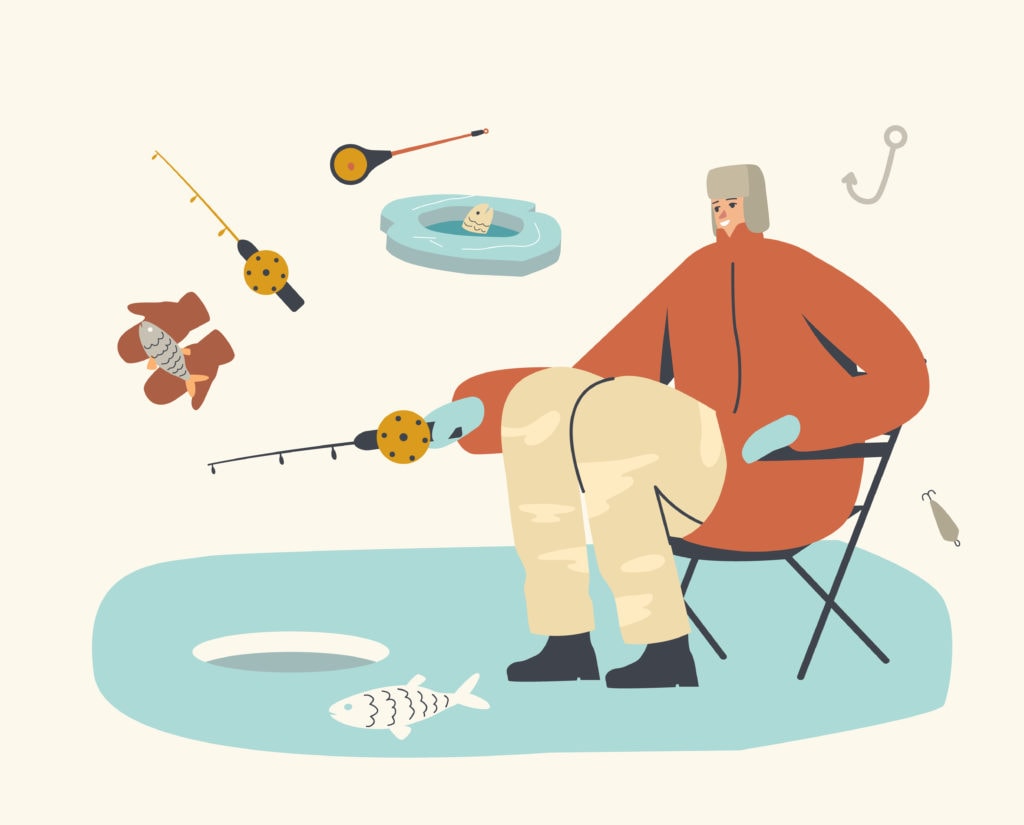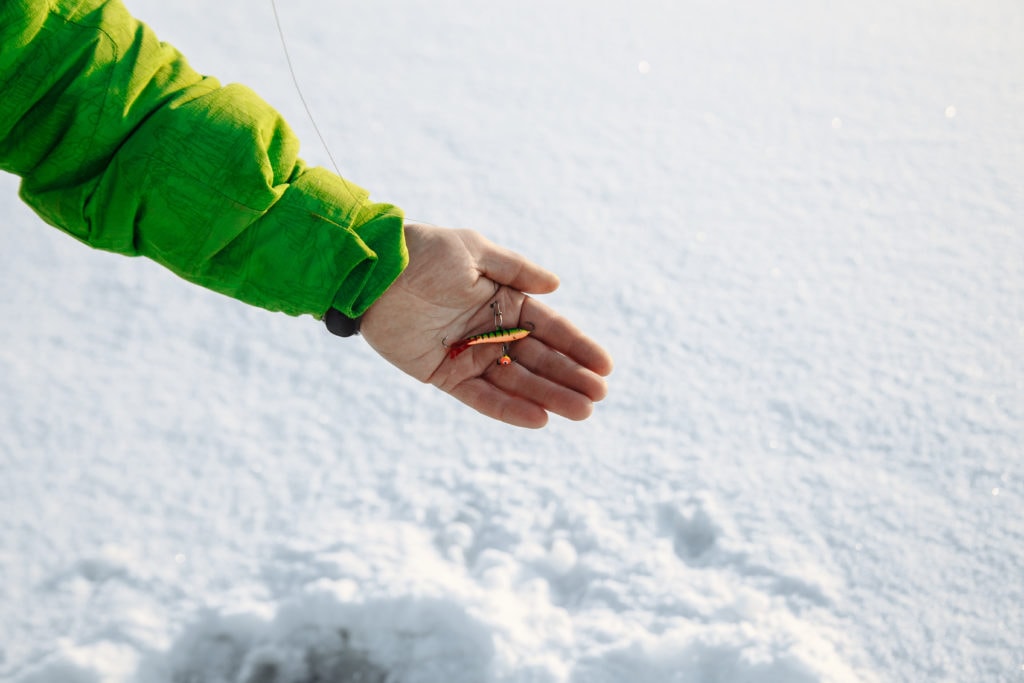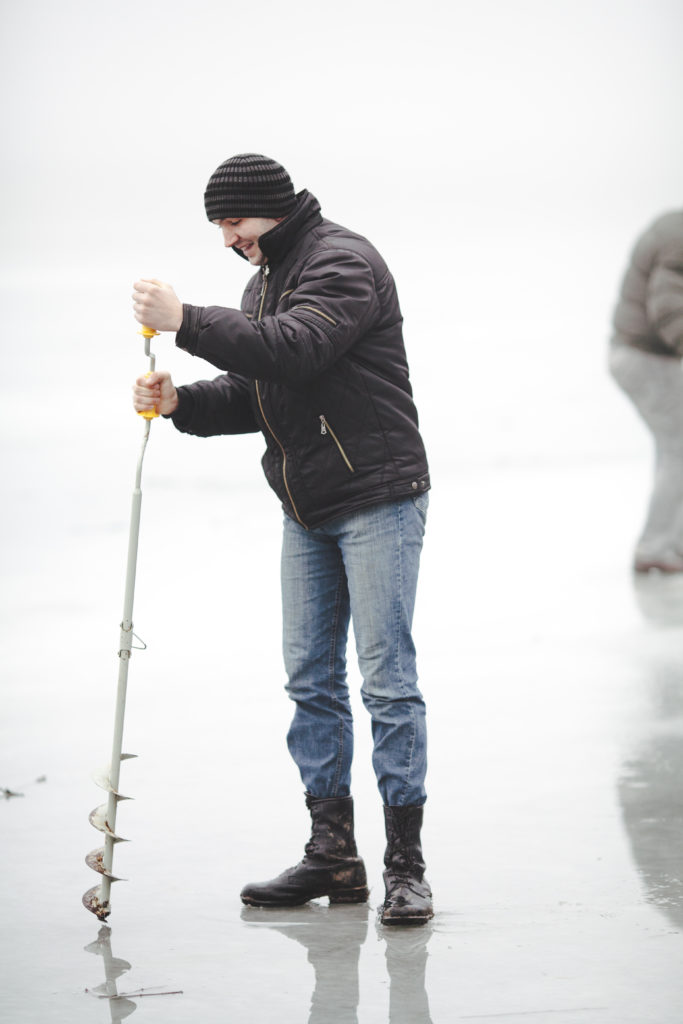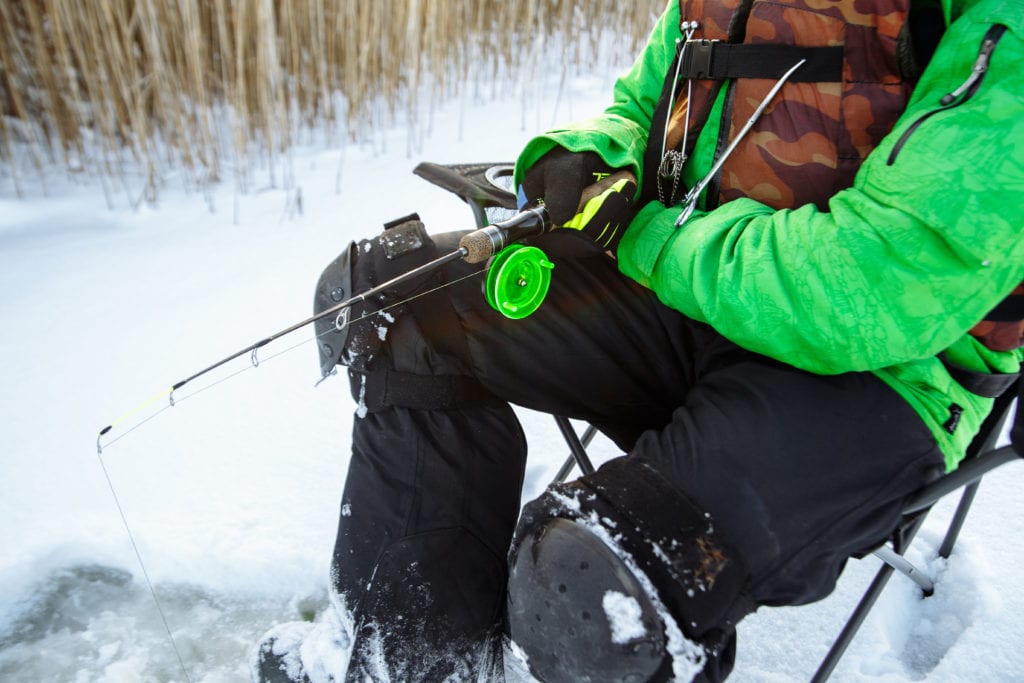If you are considering taking up ice fishing, good for you. This type of fishing is unlike any other and will surely keep you on your game. We are here to give you all the information you need whether you are an experienced ice fisherman or are getting ready to start.

This article will cover the necessary ice fishing equipment, how to choose ice fishing equipment, and plenty of ice fishing tips to help you out. If you want to jump straight to your most pressing question, use our table of contents to get you there faster.
Ice Fishing Basics
Ice fishing is not for the faint of heart. It takes patience, endurance, and preparation due to the unique nature of this activity. If you are a beginner, you likely want to know more about what this is and how the whole process works.
Well, buckle in, and let’s get started.
What is Ice Fishing?
Ice fishing begins with a pole, some line, and a hole in the ice. Pretty simple right? Well, there’s some technique you will learn along the way too.

Historians have determined that ice fishing has been around for around 2000 years and has been traced back to native tribes. This sport is popular all around the world including in North America and Northern Europe.
It is enjoyed in the US states like Vermont, Minnesota, Alaska, Wisconsin, and New York, to name a few. It is also a pastime many Canadians enjoy.
Basic Fly Fishing Equipment
You can’t pick up any pole and head out to your nearest frozen lake. This type of fishing requires some specific types of equipment.
Bib
When fishing you might feel uncomfortable if you get wet and a bib is a great way to protect against that. When ice fishing, the cold can actually be dangerous and therefore, an ice fishing bib is a piece of equipment you really shouldn’t do without.
Boots
The same is true of ice fishing boots. You absolutely need to protect your feet against the subzero temps of the ice and water to keep yourself safe from frostbite.

Gloves
You have to hold your rod and navigate any catches you get. This means your hands will be exposed to the freezing temperatures and icy waters. Get a pair of insulated, waterproof gloves to protect yourself.
Ice Rod and Reel
As stated above, the method of ice fishing is very different from other types. You will need a special ice fishing rod coupled with an ice fishing reel to be successful. These are made especially to withstand the conditions that come along with ice fishing. Be sure you pair these with a durable fishing line made to withstand the cold temps.
Tip Ups
Tip ups are used to suspend your line and bait over a hole in the ice without having to hold it the whole time. This is important because not moving your limbs can allow the cold to set in. Tip ups allow your hands to remain free for movement while holding your bait in place. A flag is usually attached that pops up when a bite is detected.

Auger
In order to fish below the ice, you need an opening and an auger is what you need to cut a nice, clean hole to drop your line into. These can be powered by hand or a variety of fuels including gas, electric, and propane. Augers are spiral blades capable of cutting through the ice to give you access to the water below.
Chair or Bucket
Ice fishing is a sport of patience. You will be outside for many hours setting, resetting, and hopefully, catching plenty of fish. Standing for this length of time is unnecessary and walking around can scare fish away from your area. You will need a chair or bucket of some kind to rest on while you wait.
Of course, there are many other supplies that can enhance your ice fishing experience, including flashers, fish finders, sleds, shelters, and shanties. You have to determine which are a necessity for you and which you can do without.
Ice Fishing Baits
The kind of bait you use will depend on what the fish in that area prefer. Shiners are a popular option. Minnows, wax worms, and small plastics with swimtails are also good choices. Small bait, lures, and jigs are often successful though it depends on the size of the species you are targeting. Popular types include perch, crappie, trout, and walleye. Check with a local bait shop to see what they recommend.
Where to Ice Fish
Your best bet is to start somewhere nearby where you are familiar with the area. Ice fishing can be successful in waters as low as three feet and up. However, you’ll have to be sure the ice is frozen well enough to walk and fish on.

The rule of thumb is that the ice should be >4 inches thick in order to walk or fish. If you bring a sled or vehicle, that thickness increases to >10-15 inches.
You can ice fish any body of water that houses fish. Ponds, lakes, bays, harbors, backwaters, and small channels off larger rivers are also good places to consider. It’s best to stay close to home when getting started and always bring a buddy!
Read Before Buying
Some materials hold up to the cold better than others and you’ll need to be selective when choosing your equipment. Cold can break things down faster, causing you to need constant replacements.
How to Choose the Right Ice Fishing Rod
Having the right rod is always essential to your success. If your rod is not suited to the type of fishing, you’ll spend more time fighting the rod than the fish.
Determine What You Are Fishing For
The body of water and region will determine what kind of fish you have to choose from. Different fish prefer different types of bait and what works for one may be ignored by other species. The size of fish will also dictate the rod you need. Having a rod that can’t handle large fish may cause you to lose that once-in-a-lifetime catch when it finally bites.
Rod Action
The action of a rod is how much bend it has. An ultra-fast or fast action rod will bend only through the tip of the rod. A medium action will bend across half the length of the rod and a slow action will bend down the entire length of the rod down to the handle.
Each of these types has a specific purpose and will be better for certain species. Fast and medium action rods are the type most often used for ice fishing due to the combination of strength and sensitivity they provide.

Rod Length
Ice fishing rods are usually somewhere between 24-36 inches although some prefer having a longer rod to keep from frightening wary fish by sitting or standing too close to the hole.
Shorter rods are ideal if using a smaller shelter or shanty. They are also lighter and easier to carry.
Longer rods will allow you to sit farther away to decrease the chance of fish avoiding the area because of your shadow. This type also better absorbs the shock of large fish, giving you a better chance at reeling them in.
Material
Fishing rods are made of graphite, fiberglass, and composites.
Graphite rods are more sensitive but also more expensive. These fast-action rods with sensitive tips allow you to quickly set the hook and give plenty of play to lure in shy fish.
Fiberglass rods are not as sensitive and tend to have more bend. This material is more durable in cold conditions and will last longer than the graphite versions.
Composite rods often use a combination of fiberglass and graphite to draw off the benefits of both with fewer downfalls. This leads to a good compromise if you are uncertain.
Ice Fishing Tips
Now, you have your equipment, your fishing spot is selected, now what? Once you have everything you need, your next step is to set up your spot, drill your hole, and start fishing. Here’s some more info to help you get set up.
How to Make an Ice Fishing Hole
When making a hole in the ice, you should first scout your spot. Be sure you know how thick the ice is and that it is safe enough to withstand drilling and standing.

Next, consider which tools you have in your arsenal. A power auger is a popular and powerful option, however, hand augers are quieter and will spook fish less.
If you have neither of these, you can opt for an ice chisel and simply hack away until you have an appropriate-sized hole.
With a power auger, you will position the blade on the ice. Take a wide stance to maintain stability while drilling. Turn it on and allow the blade to do the work. In moments, you’ll have a perfect fishing hole.
When using a hand auger, your own strength will power the blade. Spinning the blade quickly will be the most effective and efficient way to make a hole in the ice.
After your hole is ready, be sure to cover your blade with the blade guard. These blades are very sharp and can cause injuries when precautions are not taken.
Lastly, if you choose an ice chisel, hit the ice in a rough circular pattern to make a sufficient hole. This method takes a bit more elbow grease but still achieves the purpose.
To see these techniques in action, check out the video below.
Ice Fishing Safety
When ice fishing, there is an inherent danger of falling through the ice. Here are some tips to keep you safe.
- Never fish alone. Always bring a buddy. Besides, who is going to take pictures of your catch?
- Evaluate the ice. As a rule of thumb, for walking onto the ice, it should be at least 4 inches thick. If bringing a sled, snowmobile, or ATV, look for ice that is at least 5 inches thick.
- Bring the right gear. If you’re on the ice, the weather will be cold and dangerous. Be sure you have layers of warm clothing with backups in your vehicle in case you get wet.
- Stay away from alcohol. First off, alcohol is dehydrating and second of all, you’ll need to stay alert of possible dangers. Alcohol dulls the senses and can affect your ability to make wise decisions.
- Listen to your surroundings. Be aware of any new sounds, particularly the sound of ice cracking.
By being prepared and aware, you can safely enjoy your ice fishing trip.

Conclusion
Whether it is your first time ice fishing or you were just looking for a few pointers, we hope this article has helped you.
Here, we mainly covered the basics. If you’re more experienced, you may want to check or add a camera, cleats, ice fishing GPS, and maybe even a heater to your ice fishing setup. Click on the links to learn more. Thanks for reading!

Big Game Logic is a participant in the Amazon Services LLC Associates Program, an affiliate advertising program designed to provide a means for us to earn fees by linking to Amazon.com and affiliated sites. Pages on this site may include affiliate links to Amazon and its affiliate sites on which the owner of this website will make a referral commission
